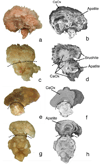Mechanisms of human kidney stone formation
- PMID: 25108546
- PMCID: PMC4285570
- DOI: 10.1007/s00240-014-0701-0
Mechanisms of human kidney stone formation
Abstract
The precise mechanisms of kidney stone formation and growth are not completely known, even though human stone disease appears to be one of the oldest diseases known to medicine. With the advent of the new digital endoscope and detailed renal physiological studies performed on well phenotyped stone formers, substantial advances have been made in our knowledge of the pathogenesis of the most common type of stone former, the idiopathic calcium oxalate stone former as well as nine other stone forming groups. The observations from our group on human stone formers and those of others on model systems have suggested four entirely different pathways for kidney stone formation. Calcium oxalate stone growth over sites of Randall's plaque appear to be the primary mode of stone formation for those patients with hypercalciuria. Overgrowths off the ends of Bellini duct plugs have been noted in most stone phenotypes, do they result in a clinical stone? Micro-lith formation does occur within the lumens of dilated inner medullary collecting ducts of cystinuric stone formers and appear to be confined to this space. Lastly, cystinuric stone formers also have numerous small, oval, smooth yellow appearing calyceal stones suggestive of formation in free solution. The scientific basis for each of these four modes of stone formation are reviewed and used to explore novel research opportunities.
Conflict of interest statement
Conflict of Interest: The authors declare that they have no conflict of interest.
Figures










References
-
- Evan AP, Lingeman JE, Coe FL, Shao Y, Parks JH, Bledsoe SB, Phillips CL, Bonsib S, Worcester EM, Sommer AJ, Kim SC, Tinmouth WW, Grynpas M. Crystal-associated nephropathy in patients with brushite nephrolithiasis. Kidney Int. 2005;67:576–591. - PubMed
-
- Evan AP, Coe FL, Lingeman JE, Shao Y, Matlaga BR, Kim SC, Bledsoe SB, Sommer AJ, Grynpas M, Philips CL, Worcester EM. Renal crystal deposits and histopathology in patients with cystine stones. Kidney Int. 2006;69:2227–2235. - PubMed
-
- Evan A, Lingeman J, Coe FL, Worcester E. Randall's plaque: pathogenesis and role in calcium oxalate nephrolithiasis. Kidney Int. 2006;69:1313–1318. - PubMed
-
- Evan AP, Lingeman J, Coe F, Shao Y, Miller N, Matlaga B, Phillips C, Sommer A, Worcester EM. Renal histopathology of stone-forming patients with distal renal tubular acidosis. Kidney Int. 2007;71:795–801. - PubMed
Publication types
MeSH terms
Grants and funding
LinkOut - more resources
Full Text Sources
Other Literature Sources

